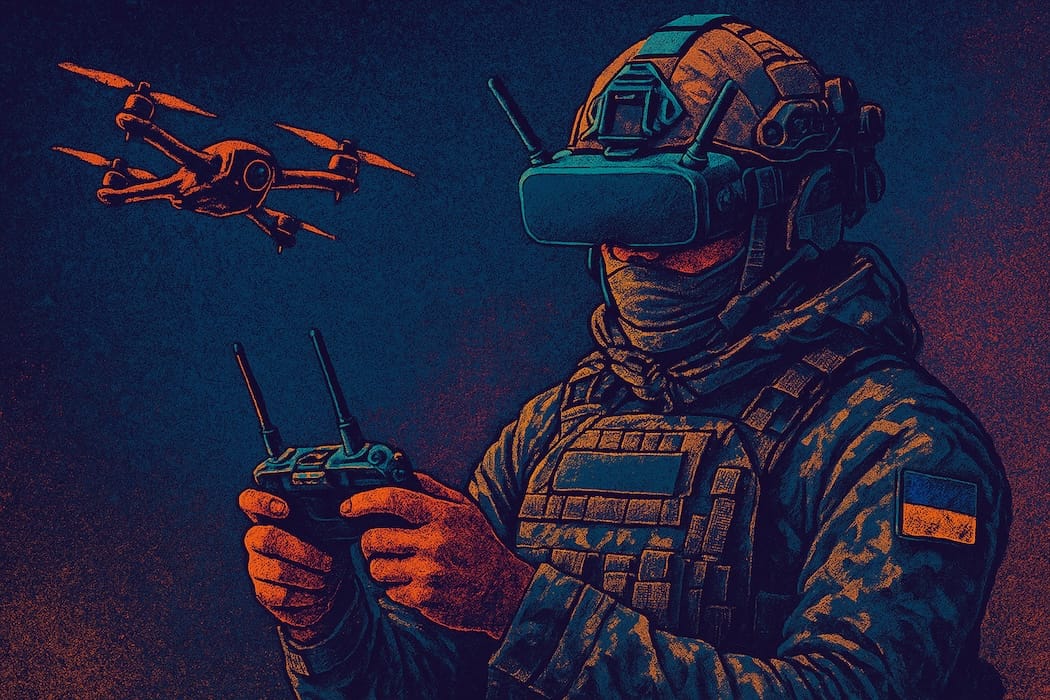Fast, Cheap, Battle-Tested: How Ukraine's Defense Tech Startups Reshape Military Innovation
From mine-hunting drones to robotic supply lines, wartime founders are building tomorrow's defense tech

KYIV, Ukraine — 5 July 2025
Ukraine now produces about 40% of its own weapons, according to President Volodymyr Zelenskyy — a dramatic shift from near-total dependence on foreign suppliers just three years ago. Behind that transformation is a surge of battlefield innovation: engineers, veterans, and founders turning wartime necessity into a decentralized, fast-moving defense-tech ecosystem.
From AI-powered drone swarms and robotic supply vehicles to electromagnetic tracking systems, Ukrainian startups are developing military solutions in weeks, not years. They’re doing it under fire, with limited capital and shifting regulations. But their speed, pragmatism, and human-centered design are setting a new global precedent.
And behind each innovation is a personal story — of reinvention, risk, and urgency.
The Demining Challenge Driving Innovation
Ukraine is now the most mine-contaminated country in the world. Government estimates suggest more than 174,000 square kilometers — an area larger than Florida — are affected. Clearing that land could cost as much as $30 billion. For many entrepreneurs, that challenge has become a mission.
Oleksandr Plakhtur, CEO of BeesAgainstMines, leads one of the most advanced efforts in civilian demining. The Kyiv-based startup has developed a modular drone system that mimics the step-by-step decision-making process of a human sapper.
Each drone in the company’s SWARM system has a defined role: vegetation clearance, object identification, explosive neutralization, and post-blast cleanup. The AI at the core of the platform is trained on real field data collected across varying soil types, temperatures, and weather conditions — enabling it to distinguish between harmless debris and active threats.
The system also logs GPS coordinates, object depth, and orientation, transmitting the data to human sappers for follow-up when needed. Survey outputs are formatted for Ukraine’s Information Management System for Mine Action (IMSMA), ensuring compatibility with national clearance efforts.
Rather than selling drones, BeesAgainstMines offers demining as a service — a model that allows them to control quality and maintain operational agility. The company is currently preparing a pilot project with a humanitarian partner, focused on reclaiming farmland for cultivation.
From Farm Fields to Front Lines
Before the invasion, Dmytro Titov, 38, was developing agricultural drones. He had invested $100,000 into building a crop-spraying UAV called the Bee. Then the war came — and with it, conscription. Titov served as a sapper before returning to civilian life with a new idea: repurpose his drone to detect mines.
With support from Brave1, the Unbreakable fund backed by Uklon co-founders, and Eric Schmidt’s D3 Fund, Titov raised about $425,000 to launch Ailand Systems. His team of 16 adapted the agricultural Bee into the ST1, a mine-detecting drone equipped with infrared cameras and low-metal-content detectors. The ST1 can fly 10–50 centimeters above ground and auto-avoid obstacles, but struggles in tall vegetation — a challenge the team is actively addressing.
The system outputs formatted survey reports for the IMSMA registry and has already been sold to two Ukrainian humanitarian demining firms. Future versions will feature night detection, higher-altitude flight, and military adaptations capable of operating under electronic warfare.
Titov is also exploring export opportunities in Mexico, where local police face IED contamination from drug cartels. He intends to return to agricultural drones once the current phase of military-focused development is complete.
Robotic Logistics at Startup Speed
In February 2024, Maksym Vasylchenko, a former food machinery technician, co-founded TenCore in response to urgent battlefield needs. What began with five employees and $26,000 in startup capital has grown into a 175-person company producing tracked ground robots used by at least 20 Ukrainian military units.
The company’s flagship product, TerMIT, is a modular unmanned ground vehicle (UGV) designed for logistics, mine-laying, medevac, and frontline resupply. It’s compact enough to fit in a station wagon, repairable with off-the-shelf parts, and controlled via Starlink uplinks in areas under drone surveillance.
What distinguishes TenCore is speed. The team works directly with front-line commanders through a live messaging group of about 40 participants who offer constant feedback. Development cycles run in days, not quarters.
Revenue reached about $1.5 million in its first year. In 2025, TenCore projects sales of approximately $80 million from over 2,000 units. Although approached by investors, Vasylchenko has opted to keep the company independent — citing the need to remain agile and closely aligned with battlefield needs rather than long procurement cycles.
International Recognition, Local Impact
Ukraine’s defense startups aren’t just scaling — they’re gaining international validation. At NATO’s 2025 Innovation Challenge in Tallinn, DONS, a startup based in the Brave1 cluster, placed third for its drone countermeasure system targeting fiber-optic controlled FPV drones.
DONS is also behind Lyut, a heavily armored tracked ground robot with fourth-class armor — capable of withstanding small arms fire and shrapnel — and a 7.62 mm mounted weapon. The platform’s most critical feature is its resistance to electronic warfare: it remains operational at ranges up to 700 meters in signal-denied environments. Lyut is now undergoing codification for use by the Ukrainian Armed Forces.
DONS represents a growing category of startups transitioning from lab prototypes to serial battlefield deployment — driven by close coordination with military stakeholders and demand for NATO-compatible systems.
Mapping the Electromagnetic Battlefield
Yehor Dudinov, a former IT professional, is tackling a less visible threat: signal warfare. His company, Falcons, builds systems that detect and locate the source of enemy jamming, radar, and drone signals up to 30 kilometers away — giving Ukrainian forces an edge in countering electronic attacks.
Falcons is funded in part by foreign defense departments who pay to observe real-time demonstrations on the battlefield. The company prioritizes Ukrainian-made components to reduce reliance on Chinese and U.S. parts, anticipating future geopolitical shifts.
Additional projects include GPS anti-spoofing technology and laser-guided drone strike systems. One early-stage venture involves low-cost solid rocket fuel to build interceptors for Shahed drones. Dudinov has emphasized the urgency of rapid prototyping, noting that front-line conditions change constantly and demand fast iteration.
A System Without an Export
Ukraine’s private defense industry now has the capacity to produce about $36 billion worth of equipment annually. But under current wartime law, exports are banned — a tension that’s becoming increasingly difficult to ignore.
Founders argue that strict licensing already exists, and that Ukraine’s reputation for battlefield-tested equipment could unlock massive foreign demand. Yuliia Vysotska, director of external affairs at the League of Defense Companies, has said Ukraine is well-positioned to provide fast, affordable, and high-quality systems to allied nations — and that these capabilities should be promoted internationally.
Beyond legal constraints, many startups face operational risks — from component shortages and airstrikes to the volatility of donor-based funding. Some have reduced their reliance on Chinese parts from 50% to 15%. Others are preemptively eliminating U.S. components in case Western support falters.
Still, most founders are focused less on policy and more on scale. The race is not just to survive — but to win, innovate, and define what comes next.
Beyond the War
What happens to this ecosystem after the war is an open question. Some technologies — like mine detection and logistics robots — have clear civilian use cases. Others may pivot to allied military exports, disaster relief, or commercial robotics.
What’s clear now is that Ukraine is pioneering a new defense-tech model: founder-driven, battlefield-tested, fast to build and fast to adapt. In contrast to Western defense contractors burdened by long procurement cycles, Ukrainian startups are shipping working systems to the front within weeks.
In a world where threats are multiplying and timelines shrinking, that model may be Ukraine’s most valuable export yet.




